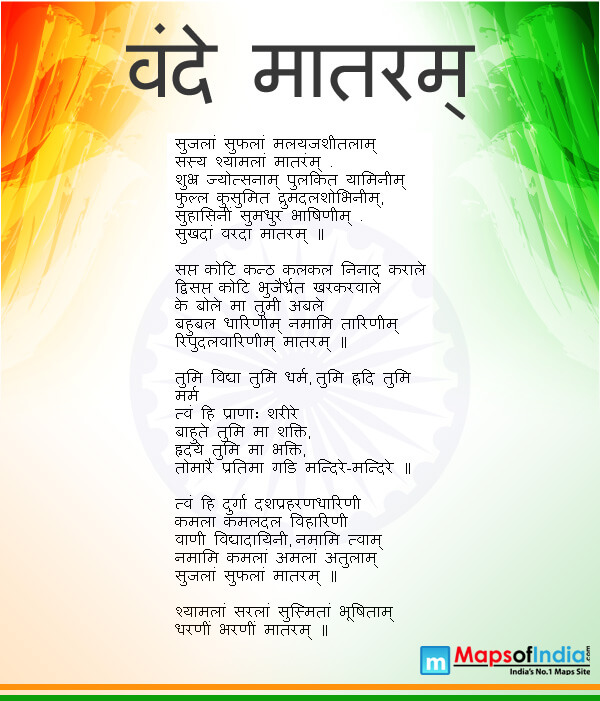Indian National Anthem Song
Indian National Anthem - Jana Gana Mana Original version with vocals Music by U.V.Niranjan. Presents 'Jana Gana Mana', the Indian national Anthem with Lyrics. Post your comments and Press the LIKE button below to show your.


Jana Gana Mana Adhinaayak Jaya Hey, Bhaarat Bhaagya Vidhaataa Panjaab Sindhu Gujarat Maraatha, Draavid Utkal Banga Vindhya Himaachal Yamuna Ganga, Uchchhal Jaladhi Taranga Tav Shubh Naamey Jaagey, Tav Shubh Aashish Maange Gaahey Tav Jayagaathaa Jana Gana Mangal Daayak, Jaya Hey Bhaarat Bhaagya Vidhaataa Jaya Hey, Jaya Hey, Jaya Hey, Jaya Jaya Jaya, Jaya Hey Jana Gana Mana - English Translation Thou art the ruler of the minds of all people, Dispenser of India's destiny. Thy name rouses the hearts of Punjab, Sindhu, Gujarat and Maratha, Of the Dravida and Orissa and Bengal; It echoes in the hills of the Vindhyas and Himalayas, mingles in the music of Jamuna and Ganges and is chanted by the waves of the Indian Sea. They pray for thy blessings and sing thy praise. The saving of all people waits in thy hand, Thou dispenser of India's destiny.
Autocad 2013 crack xforce. CAD 2013 with Crack [Fix]| 655 MB Design and shape the world around you with the powerful, flexible features in Auto.
Victory, victory, victory to thee. Indian National Anthem Jana Gana Mana Lyrics (with English Translation) written by Rabindranath Tagore. Jana Gana Mana is the national anthem of India. It is writtern Sanskritized Bengali, it is composed and scored by Nobel laureate Rabindranath Tagore. Jana Gana Mana was officially adopted as the Indian national anthem on January 24, 1950. A formal rendition of the national anthem takes fifty-two seconds. A shortened version consisting of the first and last lines (and taking about 20 seconds to play) is also staged occasionally.
 Singer(s): Rabindranath Tagore Movie/Album: Lyricist: Rabindranath Tagore Music: Rabindranath Tagore Year: 1570.
Singer(s): Rabindranath Tagore Movie/Album: Lyricist: Rabindranath Tagore Music: Rabindranath Tagore Year: 1570.
National Flag • India National Flag was adopted by constituent assembly of India on July 22, 1947. • A tricolor flag was first accepted by the Indian National Congress in 1931, having Charkha in place of today’s Chakra. • Indian national flag is a horizontal tricolour which three colours have meanings, deep Saffron at top ( stands for courage, sacrifice and renunciation), White at middle (shows truth and purity in thoughts), dark green at the bottom (symbol of life abundance and prosperity). • A wheel (Chakra) in centre of the white strip is the symbol of progress and movements. It has 24 spokes.
• Length to Breadth of National flag is in the ratio 3:2. • Supreme Court declared the right to hoist flag as a Fundamental Right under Article 19 i) (a) of the constitution in 2002.
Flag hoisting in India is regulated by flag code of India, 2002. • The flag was designed by Pingali Venkayya and first time, the flag was hoisted by Sacchindra Prasad Bose in 1906 at Calcutta and later on in year 1907, an another tricolor flag was unfurled by Madam Bhikaji Cama in stuttgart. • The first national flag committee was headed by Dr. Rajendra Prasad. National Emblem • National anthem is adopted from the Sarnath Lion Capital of Asoka on January 26, 1950. • In national emblem of India, only are three lions are visible, the fourth lion is being hidden. Adobe cs6 crack free download. • The wheel appears in relief in the centre of the abacus with a bull on right and a horse on left.
Indian National Anthem Song Lyrics
The bell shaped lotus (as in the original) has been omitted. The other animals present in the emblem are:- An Elephant and a lion. • The words Satyameva Jayateare inscribed below the abacus in Devanagiri script. These words are taken from Mundaka Upanishad. • Similar structure of Sarnath lion capital was also found in Thailand. National Calendar National Calendar is based on Saka Era (began on 78 A.D.) with Chaitra as its first month and Phalguna as its last month with a normal year of 365 days adopted from March 22, 1957 along with the Gregorian Calendar. National Anthem • National Anthem of India is ‘ Jana gana mana‘ which was composed by Rabindra Nath Tagore in 1911, originally in bengali.